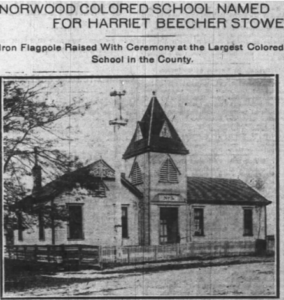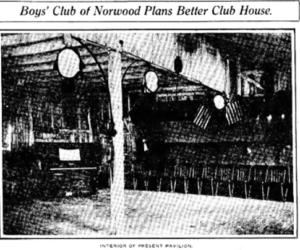
“My greatest ambition is for my race. I want to see my people succeed. I want to see them have an equal chance.”
– Ada B. Harris[1]
In the late 1800s and early 1900s the neighborhood of Norwood, which lay Southeast of downtown Indianapolis, was one of the most vibrant Black communities in the area. Originating during the Civil War, the 28th U.S. Colored Troops (USCT) drilled a Camp Freemont near present-day Norwood, and, at the end of the war, many returned to the area and set down roots. The neighborhood was bolstered by the Great Migration during which Black Americans moved North to seek better economic opportunities and flee from Southern racial violence and discrimination.[2]
Living in a highly segregated society, the Norwood community struggled with poor infrastructure, poverty, and subpar sanitation during its early years. However, by 1909, something had changed within Norwood. The Indianapolis Star wrote, “A few years ago. . . Norwood was a moral blot on the map of Marion County. . .Today Norwood is a placid collection of homes. The stranger is accorded courtesy, and lawbreaking is almost unknown.” The article continued by discussing the infrastructure improvements noting, “Where a few years ago the settlement had no place for amusement, the town now boasts of a Boys’ Clubhouse, a dancing pavilion, run for the club’s benefit, and a little park with seats, grass and flowers.” When the newspaper talked with residents about the improvements and its origins, they found that, “with the same sureness that all roads lead to Rome, each circumstance goes directly to one source— Miss Ada Harris.”[3]
Reformer and educator Ada B. Harris embraced the Progressive Era philosophy of improvement and applied it to her community, championing a myriad of causes. An accomplished woman, Harris’s list of achievements is long enough to merit two blog posts examining her work as both an educator and progressive reformer. This post explores Harris’s decades-long career as a teacher and principal at Norwood’s Harriett Beecher Stowe School and her efforts to establish communal spaces and amenities for the Norwood neighborhood. In doing so, she boldly challenged local racial prejudice and elevated the welfare of Black Hoosiers in the segregated city.

Harris was born on August 15, 1866, in Campbell, Kentucky to Robert Harris and Hannah Tolliver. She moved with her mother to Indianapolis as a child and graduated from Indianapolis High School (later renamed Shortridge High School) in 1888.[4] Upon graduation, Harris began teaching at School No. 5 in Norwood. At the time, School No. 5 was one-room schoolhouse that operated independently from the Indianapolis Public School System (IPS). It was one of the few schools that hired Black teachers and taught Black children in the segregated city. Harris stepped into a leadership position early on and was officially appointed principal by 1903, the same year the community decided to rename the school Harriett Beecher Stowe School No. 5 after the abolitionist.[5]

Under Harris’s leadership, the school grew exponentially. In 1896, Harriett Beecher Stowed enrolled approximately 53 students. By 1903, enrollment was listed at over 150 pupils. Education was a core priority for the Norwood community. Ada B. Harris and other Indianapolis residents were inspired by author and activist W. E. B. Du Bois’s ideology. He argued that education, economic independence, and political activism were key to achieving full civil rights for the Black community. This philosophy turned educational settings such as School No. 5 into one of the central battlegrounds for the blooming Civil Rights Movement and struggle for equality in Reconstruction America.
The Indianapolis News described Harris as “a thorough teacher, loved and honored by every child of her school.”[6] Harris endeavored to provide students with a quality education and instill a sense of social responsibility in them. She hosted annual Thanksgiving dinners for the students, which “consisted of turkey, cranberry sauce, scalloped oysters, vegetables, pumpkin pie, ice cream, and cake.”[7] She also introduced sewing classes, organized and directed the school plays, and founded a parent’s club to involve them in their child’s education.[8] Steeped in the ideals of civic virtue, Harris attempted to instill those same morals into her students. In March of 1913, she and twenty of her students visited the county treasurer and filed their parents’ taxes. She emphasized that it was every citizen’s obligation to pay taxes and impressed a feeling of responsibility in the children.[9] Surely, the parents appreciated the field trip as well that year.
In 1912, Norwood was annexed by Indianapolis and the school incorporated into the Indianapolis Public School system.[10] School No. 5 became IPS No. 64, and Harris remained principal until her resignation in 1924.[11] In addition to teaching at No. 64, Harris also served as a vocational instructor for Emmerich Manual Training High School in 1921.[12] After resigning from School No. 64, Harris attended Butler College at the age of 60 and earned a college degree to “prepare herself for the more recent demands of the city schools.” Harris then accepted a teaching position at Rockville High School, but unfortunately suffered from a series of strokes and spent limited time at Rockville before passing away on September 9, 1927.[13] Throughout her career, Norwood residents praised her dedication to its students, and she consistently went above and beyond to provide them with not only a quality education but prepare them for their adult lives.
Perhaps one of Harris’s most impactful endeavors was establishing and leading the Boys’ Lookout Club. Established in 1904, the club’s objective was “the upbuilding of character and the general improvement of their [the boys] social condition.” Harris achieved this through teaching different skills related to social responsibility and civic virtue such as “good deportment in the home and public places, [and] kindness to animals and kindred subjects.”[14] The Boys’ Club met twice a month after school and early on they began fundraising to purchase land for a public gymnasium, reading room, and park for the community. A brilliant grassroots organizer, Harris led club efforts to solicit subscriptions for the land from Norwood residents. Her efforts proved wildly successful. In less than a year, the club bought land on Prospect Street for $2,000 to serve as the official Boys’ Club grounds. The property had a four-room farmhouse, a small brick building, and a barn, which was transformed into the Boys’ Club Pavilion. The club worked to transform the space, and it soon opened as a public park and picnic grounds for Norwood.[15] In an area with poor infrastructure and investment, the Boys’ Club grounds served as a key communal space for residents to relax, hold events, and socialize with one another.

Harris and the Boy’s Club soon set their sights on building a gymnasium. In August of 1907, the club organized a four-night carnival to fundraise for the gymnasium. In 1909, while reporting on the Boys’ Club, the Indianapolis Star wrote that “Miss Harris has so carefully handled the business affairs of the club in the past that she has already received promises of the support of many of the leading colored men and women of Indianapolis,” for the gymnasium. The gymnasium was successfully opened by 1910.[16] Harris’s ability to fundraise and organize for both the gym and club grounds demonstrates her strong leadership skills and influence. A grassroots endeavor, these efforts also show Norwood residents’ strong resolve to transform the area, which had received limited investment and infrastructure amid segregation, into a vibrant community. This community-driven mindset is still present in Norwood today through groups such as the Norwood Neighborhood Association which has advocated against the gentrification of the area.
In 1911, Harris organized a children’s library association to fundraise for a community library on the Boys’ Club grounds.[17] According to the Indianapolis News, this was in response to the Norwood school library burning down two years prior. Harris personally started the book collection for the library and began soliciting book donations. The library was opened officially in September of 1912 and the Indianapolis Star heralded it as the “first colored library in Indianapolis.”[18] The library opened with a collection of 1,000 books and opened professional opportunities for Black residents including Willa Resnover, who served as Norwood’s first librarian.[19] Ultimately, Harris’s leadership and exceptional fundraising abilities mobilized the Norwood neighborhood to invest in their community and, in response to segregation, create their own communal spaces to socialize, relax, and connect with one another.
Even after Harris’s death in 1927, the fruits of her grassroots organization and educational leadership have continued into modern day. Harriett Beecher Stowe School No. 64 operated and served the Norwood neighborhood for over a century, closing in 2009. Pride Park stands on the former property of the Boys’ Lookout Club and, in 2024, will be receiving new playground equipment. Modern-day Norwood residents take pride in the neighborhood’s roots and seek to honor its legacy by fostering the community’s tight-knit bonds and spearheading efforts to preserve its rich history. Many residents, such as Madonna Shaffner, can still trace their roots back to the 28th Indiana Infantry. Others have advocated for the establishment of “an intergenerational heritage center that would both honor Norwood’s past and provide a high-quality venue for community strengthening services and programming.” In many ways, the current residents echo and continue Harris’ legacy, seeking to continually improve Norwood’s housing, infrastructure, public services, and public education. Much of the community’s vibrancy and qualities can be attributed to a single dedicated teacher.
Part II examines Harris’s work as a progressive reformer beyond the classroom. It explores her work establishing a fresh-air tuberculosis camp, championing Black women’s suffrage, and patriotic homefront work during World War I. Stay tuned!
Notes:
[1] Indianapolis Star, August 1, 1909, 33, accessed Newspapers.com.
[2] Background History of Norwood Neighborhood, Norwood Neighborhood, Indianapolis Bicentennial Collection, 2019_0006, accessed Indiana Historical Society Digital Collections.
[3] “Former ‘Bad’ Town Now an Ideal Spot,” Indianapolis Star, August 1, 1909, 25, accessed Newspapers.com.
[4] “High School Commencement,” Indianapolis Journal, February 4, 1888, 3, accessed Hoosier State Chronicles.
[5] “Dedicate a Flagpole,” Indianapolis Star, September 8, 1903, 10, accessed Newspapers.com; “Harriet Beecher Stowe: Flagpole Raised with Ceremony at Norwood School,” Indianapolis Recorder, September 12, 1903, 1, accessed Newspapers.com; A Historical Sketch of School No. 64, 1953, Indianapolis Public Schools Digital Collection, accessed Indianapolis Public Library; History of Harriet Beecher Stowe School 64, 1969, Indianapolis Public Schools Digital Collection, accessed Indianapolis Public Library.
[6] “The Norwood School Trouble,” Indianapolis News, January 16, 1899, 8, accessed Newspapers.com.
[7] “Dinner Served at School,” Indianapolis News, November 26, 1903, 8, accessed Newspapers.com.
[8] Indianapolis News, April 3, 1909, 5, accessed Newspapers.com; “Pupils appear in Play,” Indianapolis Star, June 9,1902, 14, accessed Newspapers.com; “Present One-Act Playlet,” Indianapolis Star, June 11, 1910, 14, accessed Newspapers.com; “A Successful Entertainment,” The Freeman, April 2, 1898, 8, accessed Google Newspapers.
[9] “To Pay Parent’s Taxes,” Indianapolis News, March 8, 1913, 4, accessed Newspapers.com.
[10] “Norwood School Now Public School No. 64,” Indianapolis Recorder, October 12, 1912, 2, accessed Hoosier State Chronicles.
[11] “Resignations,” Indianapolis Star, June 18, 1924, 14, accessed Newspapers.com.
[12] “Instructors Appointed,” Indianapolis Star, September 28, 1921, 15, accessed Newspapers.com.
[13] “Former Teacher is Dead,” Indianapolis News, September 17, 1927, 39, accessed Newspapers.com.
[14] “Boys’ Club at Norwood,” Indianapolis News, May 21, 1904, 9, accessed Newspapers.com.
[15] “Building for Norwood Youth,” Indianapolis News, June 23, 1906, 8, accessed Newspapers.com; “Gymnasium for the Norwood Youth,” The Freeman, July 7, 1906, 4, accessed Google Newspapers; “Negroes may Have Club,” Indianapolis Star, July 22, 1906, 13, accessed Newspapers.com.
[16] Advertisement for a Boys’ Club Carnival, Indianapolis News, August 10, 1907, 11, accessed Newspapers.com; “Boys’ Club of Norwood Plans Better Club House,” Indianapolis Star, June 16, 1909, 9, accessed Newspapers.com.
[17] “For Library at Norwood,” Indianapolis News, April 24, 1911, 4, accessed Newspapers.com.
[18] “City’s First Colored Library is Dedicated,” Indianapolis Star, September 23, 1912,12, accessed Newspapers.com.
[19] “Norwood Library,” Indianapolis Recorder, May 6, 1911, 1, accessed Hoosier State Chronicles; “Norwood has a Library,” The Freeman, September 21, 1912, 8, accessed Google Newspapers.
